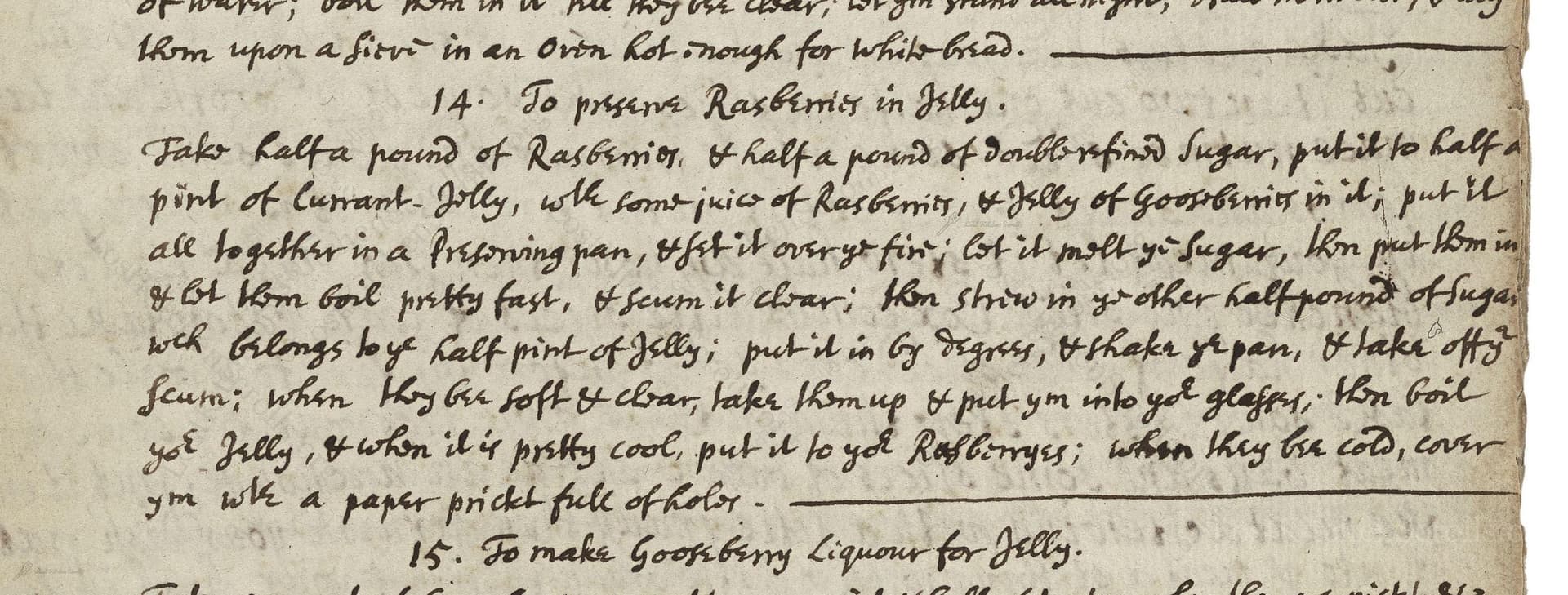To Preserve Rasberries In Jelly
From the treasured pages of Cookbook of Mary Cruso and Timothy Cruso
Written by Mary Cruso

To Preserve Rasberries In Jelly
"Take half a pound of Rasberries, & half a pound of double refined Sugar, put it to half a pint of Currant-Jelly, with some juice of Rasberries, & Jelly of Gooseberries in it; put it all together in a Preserving pan, & set it over ye fire; let it melt ye Sugar, then put them in & let them boil pretty fast, & scum it clear; then strow in ye other half pound of Sugar; when they be soft & clear, put it in by degrees, & shake ye pan, & take off ye scum; when they be soft & clear, lay them up & put ym into yor glasses; then boil ye Jelly, & when it is pretty cool, put it to yor Rasberryes; when they be cold, cover ym with a paper prickt full of holes"
Note on the Original Text
Early modern recipes like this were written with little standardization. Spelling was highly variable (‘rasberries’, ‘yor’, ‘ye’), and quantities were based on what was available. Directions are conversational—cooks were expected to rely on intuition and experience. The period’s language (‘scum it clear’, ‘strow in ye other half pound of Sugar’) reflects the practical, hands-on way these instructions were transmitted, more as helpful notes than as strict formulas.

Title
Cookbook of Mary Cruso and Timothy Cruso (1689)
You can also click the book image above to peruse the original tome
Writer
Mary Cruso
Era
1689
Publisher
Unknown
Background
Step into the flavorful world of 17th-century cuisine with Mary Cruso’s delightful collection, where time-honored recipes and inventive cookery tips offer a peek at the tastes and talents of yesteryear’s domestic kitchens.
Kindly made available by
Folger Shakespeare Library
This recipe comes from a 1689 manuscript by Mary Cruso, at a time when preserving fruit was both a necessity and a luxury. Sugar was expensive, so these jellied preserves were often made to showcase precious berries at their best, stretching their season well beyond summer. Jellied fruit preserves like this were often presented at the table in glass or silver dishes as a display of wealth and culinary skill. The method also reflects the era’s growing enthusiasm for refined, elegant sweets among England’s upper classes.

The original recipe would have required a wide, shallow brass or copper preserving pan and a gentle fire—perhaps a charcoal brazier or hearth. Wooden spoons or skimmers were used for stirring and removing scum. Sieves or muslin cloths helped to extract juice. The finished preserves went into small glass jars or tall glasses, covered with parchment pricked to allow air to escape but keep dust and insects out.
Prep Time
10 mins
Cook Time
20 mins
Servings
8
We've done our best to adapt this historical recipe for modern kitchens, but some details may still need refinement. We warmly welcome feedback from fellow cooks and culinary historians — your insights support the entire community!
Ingredients
- 8 oz fresh raspberries
- 8 oz granulated sugar
- 1 cup redcurrant jelly
- 0.5–1 fl oz raspberry juice (strained)
- 0.5 fl oz gooseberry jelly (or substitute with extra redcurrant jelly)
Instructions
- To make Raspberry Jelly Preserve in a modern kitchen, take 8 ounces of fresh raspberries and 8 ounces of granulated (or caster) sugar.
- Prepare 1 cup of redcurrant jelly, and add a tablespoon or two (0.5–1 fluid ounce) of raspberry juice (simply pressed raspberries through a sieve).
- If possible, add a tablespoon (about 0.5 fluid ounce) of gooseberry jelly for tartness, or more redcurrant jelly as a substitute.
- In a heavy saucepan, combine the currant jelly, raspberry juice, gooseberry jelly, and half the sugar (about 4 ounces).
- Heat gently until the sugar dissolves, then add the raspberries.
- Bring to a brisk boil, removing any foam (scum) that rises to the surface.
- After several minutes, sprinkle in the remaining sugar gradually, shaking or swirling the pan gently rather than stirring.
- Continue boiling until the raspberries look soft and glossy, and the syrup thickens slightly.
- Spoon the fruit into clean jars.
- Boil the syrup a minute longer if needed, then pour over the fruit.
- When cool, seal the jars or cover with parchment pricked with holes to mimic the historical method.
Estimated Calories
75 per serving
Cooking Estimates
It will take about 10 minutes to prepare your ingredients and workspace, and about 20 minutes to cook the preserve. Each serving contains about 75 calories. This recipe makes 8 servings.
As noted above, we have made our best effort to translate and adapt this historical recipe for modern kitchens, taking into account ingredients nowadays, cooking techniques, measurements, and so on. However, historical recipes often contain assumptions that require interpretation.
We'd love for anyone to help improve these adaptations. Community contributions are highly welcome. If you have suggestions, corrections, or cooking tips based on your experience with this recipe, please share them below.
Join the Discussion
Rate This Recipe
Dietary Preference
Main Ingredients
Culinary Technique

Den Bockfisch In Einer Fleisch Suppen Zu Kochen
This recipe hails from a German manuscript cookbook compiled in 1696, a time whe...

Die Grieß Nudlen Zumachen
This recipe comes from a rather mysterious manuscript cookbook, penned anonymous...

Ein Boudain
This recipe comes from an anonymous German-language manuscript cookbook from 169...

Ein Gesaltzen Citroni
This recipe, dating from 1696, comes from an extensive anonymous German cookbook...
Browse our complete collection of time-honored recipes



